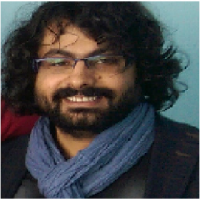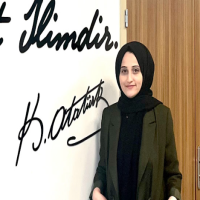Research Article
Issue Reviewers

 0000-0002-7756-3835
0000-0002-7756-3835
 0000-0002-7268-4320
0000-0002-7268-4320







Aim & Scope
Journal of Health and Social Welfare Research (E-ISSN: 2667-8217) is an international blind, peer-reviewed and open-access e-journal that started its publication life in 2018. The aim of the journal is that scientists share their knowledge and contribute to the literature in order to lead scientific efforts in all fields including Health Management, Health Economics, Health Tourism, Medical Tourism, Economy, Business Administration, Sustainable Development, Public Health and Social Welfare and other multidisciplinary sciences. is to create a scientific platform where they can present their free scientific ideas in the light of science internationally. Journal of Health and Social Welfare Research accepts research articles and review articles prepared in Turkish or English on all topics related to health and social welfare. The journal is published twice a year, in January and July.
Journal of Health and Social Welfare Studies accepts research articles and review articles prepared in Turkish or English on all subjects covering Health Management, Health Economics, Health Tourism, Medical Tourism, Economics, Business Administration, Sustainable Development, Public Health and Social Welfare and other multidisciplinary sciences. Evaluation fee and application fee are not collected from the articles sent to the journal. Articles submitted for publication in the journal must be prepared in accordance with the rules of research and publication ethics. The Journal of Health and Social Welfare Research observes the publication ethics principles, standards and recommendations set by COPE (Committee on Publication Ethics) and ICMJE (International Committee of Medical Journal Editors). The articles submitted for publication in the journal are passed through the Turnitin plagiarism program. Articles with a plagiarism rate of more than 20% are rejected without being evaluated. Journal of Health and Social Welfare Research is an e-journal that has adopted an open access policy. The views in the articles published in the journal are not the views of the journal. All responsibility belongs to the authors. No royalties are paid to authors in cash.
Writing Rules
1. Articles should be prepared in “MS Office Word 2010” or higher version, in A4 size, using the journal article template. Its length should not exceed 30 pages in journal format. Page layout; Top: 5 cm, Bottom: 2.5 cm, Left 2.5 cm and Right: 2.5 cm.
2. Author information, additional article information and author statements should be added to the sections specified in the journal article template in accordance with journal rules.
3. Except for the title page and the extended summary page, the article should be written in 10 font size, "Times New Roman" and single line spacing. In the text, a character break should be given after commas and periods. Starting indent should not be used in paragraphs, 6 pt space should be left before and after the paragraph. No additional blank lines should be left between paragraphs.
4. On the title page of the article; Title in Turkish and English in 11 points, in a single line spacing and before and after the paragraph using 3 pt space, in 9 points, in a single paragraph consisting of at least 120 and maximum 200 words in Turkish and English, at least 3 and at most 5 in Turkish and English keywords and maximum 5 JEL (Journal of Economic Literature) classification codes should be given. In the articles whose language is English, the title, abstract, keywords and JEL classification codes should be given in English first and then in Turkish.
5. The article should contain an extended summary of minimum 700 and maximum 1200 words, not exceeding 1 page in total, according to the journal page format. Extended abstract should be prepared in English for Turkish articles and in Turkish for English articles (For authors who do not speak Turkish, Turkish extended abstracts for English articles will be prepared by the journal secretariat). Extended summary; it should consist of four subtitles: purpose and scope, method (design/methodology/approach), findings, and conclusion and discussion. Each subheading should be written in a single paragraph, 9 font size, single line spacing, using 3nk space before and after the paragraph, and without leaving any additional blank lines between the headings.
6. The headings and subheadings should be appeared in 10 font size, bold and left justified and also numbered decimally such as 1., 1.1., 1.1.1., 1.1.2., 1.1.2.1. The numbering should be initiated from the “Introduction” part and should be continued till the “Conclusion” part. No titles for introduction and result part should be used. All the letters in main headings should be capital; only the first letters of the words in the sub-headings should be capital. No spacing should be made before and after the main and sub-headings. Only in the main headings 12nk spacing before the paragraph, and 6nk spacing after the paragraph should be applied.
7. All the tables and figures in the article should be given centered and in their proper places. All the tables and figures should be numbered in bold (Table 1., Figure 2., etc.) and given titles in normal fonts. For the Tables, the titles should be given above while it should be given under the Figures. The titles should be centered, should be written in 10 font size, only the initial letters should be capitalized, and 6nk distance must be set before and after the paragraph. The text inside the Tables and Figures should be written in Times New Roman with 8-9 font sizes and with single spacing. All the visuals such as graphs, charts, maps, drawings and photographs should be specified as Figures. All the Tables and Figures should fit the aforementioned rules and should be legible. The sources in Tables and Figures should be given under the Table and Figure with 8 font size and 3nkt distance must be set before and after the paragraph. No blank line should be given before and after the Tables and Figures.
8. The equations, models and formulas in the article should be left justified, all of them should be numbered and the numbers should be written in parentheses and right justified. No blank line should be given before and after the equations, models and formulas.
9. The bulleted texts in the article, should be left justified and 3nk distance must be set before and after the paragraph.
10. If the quotation from a source is less than 40 words, the expressions should be in quotation marks and the study quoted should be cited intext. If the quotation is more than 40 words, the quotation should be given italic and in a new line; 1.25 cm tabbed from left and right, 3nk distance must be set before and after the paragraph and the study quoted should be cited.
11. If the article include any “appendix”, titles (Appendix 1., Appendix 2., etc.) should be given to them and they should be given after the References part.
12. Intext citations, footnotes and reference lists in the papers should be prepared according to American Psychological Association (APA 6) style. The intext references should be given with author-date method. The explanations should be given at the button of the page as a footnote, as justified, with 8 font size and Times New Roman, single line spacing and 3nk distance must be set before and after the paragraph.
13. Intext citations should include the surname of the author(s) and year of the source respectively. If the papers do not have an author then the name of the institution should be given instead of author’s name.
• Works by a single author: (Çapar, 2019).
• Works by two authors: (Çapar and Çınar, 2021).
• Citing more than one source: (Çakmak, 2021; Çınar et al., 2021; Çapar andÇınar, 2021).
• Citing whole source: (Çapar, 2019).
• Citing publications without the name of the author: (MTI, 2021).
14. In the first quotation of a study that is prepared by three, four or five authors the surnames of all authors should be given. In the following quotations, only the surname of the first author and et al. should be written.
• The first citation intext: (Çapar, Çakmak and Çilhoroz, 2021).
• Other citations intext: (Çapar et al., 2021).
15. For those papers having six or more authors, only the surname of the first author should be mentioned.
• Intext citations: (Çınar et al., 2017).
16. If the reference is taken from a web site and the author is known, reference should be made like periodic publications. If the date of the downloaded source is not given, access date should be used. If the date of the downloaded source is not given, date of access should be used. Also if no publisher name is available, use the name of website and data of Access.
• If the author’s name and publication year is known: (Çapar, 2021).
• If the author’s name and publication year is not known: (Turkish Statistical Institute, 2021).
17. If you are citing more than one work by the same author in the same year, put the letters a, b, c next to the year.
• (Çapar, 2021a).
• (Çapar, 2021b).
• (Çapar, 2021c).
18. If the name of the author is used in the text, the reference should be given as follows:
• According to Çapar (2021),……
19. In the articles, all kind of sources should be included in the References part. All the sources, without discriminating according to the type (thesis, book, article, report etc.), should be sorted alphabetically according to the surname of the authors. The studies of a particular author should be sorted in the References part from the oldest to the newest. Sources should be left justified in the first line, and 1.25 cm tabbed from left in the following lines. For that purpose, in the paragraph preferences “first line” should be adjusted to “hanging” and the value should be adjusted to 1.25 cm. In the References part, the first letter of the name of all publications (article title, book title, chapter title, thesis title etc.) except Journal title should be capital, and the rest of the title should be lower case, ,if they are not proper name or abbreviation. For the title of a journal, the fist letters of all words should be capital. The reference page should be prepared according to example shown below.
Books:
Surname, First letter of the name of the author(s). (Year). Name of the book. Place of publication: Publisher.
Çapar, H. (2021). Sağlık Turizminde Öne Çıkan Ülkeler. Ankara: Nobel Yayınları.
Arslanoğlu, A., Gemlik H. N., and Bektemur G. (2019). Sağlık Hizmetleri Dört Boyut. İstanbul: Detay Yayıncılık.
Korkmaz, A., Dulupçu, M. A., Gövdere, B., and Songur, H. (2013). İnsani ücret. İstanbul: İGİAD Yayınları.
Translated Books:
Surname, First letter of the name of the author(s). (Year). Name of the book. First letter of the translator. Surname of the translator (Trans.), Place of publication: Publisher.
Drucker, P. (1994). Kapitalist ötesi toplum. B. Çorakçı (Trans.), İstanbul: İnkilap Kitabevi.
Edited Books:
Surname, First letter of the name of the author(s). (Year). Section title. First letter of the editor. Surname of the editor (Ed.), Title of the book in (Pages of the section), Place of publication: Publisher.
Okçu, M., Aktel, M. ve Kerman, U. (2007). İki süreci anlamak: Kamu yönetiminde küreselleşme ve Avrupalılaşma. A. Yılmaz ve Y. Bozkurt (Ed.), Küresel esintiler ve yerel etkiler sarmalında Türk kamu yönetimi içinde (43-67), Ankara: Gazi Kitabevi.
Articles:
Surname, First letter of the name of the author(s). (Year). Title of the article. Journal title, Vol(No), Pages.
Çapar, H. (2019). Sağlık Alanında Meslekleşme ve Türkiye’nin Yaşadığı Sorunlar: Yeni Mesleklere Doğru. Ankara Hacı Bayram Veli Üniversitesi İktisadi ve İdari Bilimler Fakültesi Dergisi, 21(3), 803-816.
Çapar, H., and Aslan, Ö. (2020). Factors Affecting Destination Choice in Medical Tourism. International Journal of Travel Medicine and Global Health, 8(2), 80-88. doi: 10.34172/ijtmgh.2020.13.
Çınar, F., Çapar, H., and Ekinci, G. (2021). Effect of COVID-19 anxiety on perceived risks and avoidance behaviors. Annals of Clinical and Analytical Medicine, 10(4), 1-18.
Thesis:
Surname, First letter of the name of the author(s). (Year). Thesis title. Master’s Thesis/ Ph.D. Dissertation, Name of Institution, Place of publication.
Çapar, H. (2018). Destinasyon Seçimini Etkileyen Faktörler: Yabancı Potansiyel Medikal Turistlerin Türkiye Algısını Ölçmeye Yönelik Bir Çalışma. Master thesis, İstanbul Üniversitesi Sağlık Bilimleri Enstitüsü, İstanbul.
Symposiums/Congresses:
Surname, First letter of the name of the author(s). (Year). Title of the paper. Symposiums/Congresses Name, Organizing institute, Date of organization, Place of organization, Pages.
Çapar, H., Çınar, F., and Arıcı, H. (2014). Communication Problems with People on the Streets during COVID-19 in terms of Social Well-being. 6. Uluslararası Sağlık Bilimleri ve Yönetimi Kongresi, Süleyman Demirel Üniversitesi, 20-22 Mayıs 2021, Isparta, 158-169.
Research Reports:
Surname, First letter of the name of the author(s). (Year). Title of the paper (Report No. xxx). Place of publication: Publisher.
Pamuk, Ş. (2007). Economic change in twentieth-century Turkey: Is the glass more than half-full? (Working Paper No.41). Paris: The American University of Paris.
Internet Sources:
Surname, First letter of the name of the author(s). (Date of publication / Date of access). Title. Access address: Internet address, (Date of access).
Bebbington, J. and Song, E. (2004). The adoption of IFRS in the EU and New Zealand. Access address: http://www.europe.canterbury.ac.nz/, (14.07.2008).
Medikal Turizm Derneği. (2021). COVID-19’un Medikal turizm Üzerindeki Etkileri. Access address: https://pubmed.ncbi.nlm.nih.gov/33901355/, (13.06.2021).
NOTE: In cases not mentioned here regarding the spelling rules, the points adopted in scientific articles should be taken into consideration.
Ethical Principles and Publication Policy
ETHICAL PRINCIPLES
Journal of Health and Social Welfare Research observes the publication ethics principles, standards and recommendations determined by COPE (Committee on Publication Ethics) and ICMJE (International Committee of Medical Journal Editors). Accordingly, all articles that do not comply with accepted ethical standards are removed from the publication. This includes articles with possible irregularities and inconsistencies detected after publication. Within the scope of publication ethics, all stakeholders are expected to have the following ethical responsibilities, and all ethical cases will be evaluated in accordance with COPE rules.
Ethical Responsibilities of Authors:
• Authors should not have published the articles they sent to the journal elsewhere or sent them for publication.
• Authors should have cited all citations used in their articles.
• The authors declare that the article is their own work, that they do not plagiarize in any way, that all responsibilities arising from plagiarism belong to them, and that the journal has no responsibility in this regard.
• Authors should ensure that they contribute scientifically to the article and it should be known that all authors have equal responsibility for the article.
• Corresponding author must ensure that all co-authors named in the article consent to publication and to be named as co-authors. All persons who have made significant contributions to the work should be named as co-authors. Other people should be included in the thank you section.
• Authors are responsible for declaring the organizations, financial resources or conflicts of interest that support the work they submit.
• Authors should provide access to the data sets in the article, if deemed necessary.
• Authors must have prepared the articles submitted for publication in the journal in accordance with the rules of research and publication ethics. Ethics committee approval must be obtained separately for studies conducted and for studies on clinical and experimental humans and animals that require an ethical committee decision, and this approval must be stated and documented in the article.
Ethical Responsibilities of Referees:
• Any selected reviewer who is not qualified to review the research or who knows that it will be impossible to evaluate the article quickly should notify the editor of this situation and seek excuses from the review process.
• The referees are obliged to keep the articles they receive confidential and not to use the information they obtained from the refereeing process for their personal benefits.
• Reviewers should not share their reports or information about the article with others and should not communicate directly with the authors without the permission of the editor.
• Reviewers should be mindful of potential ethical issues in the manuscript and bring them to the attention of the editor. This includes substantive similarity and overlap between the review article and any other published work of which the reviewer has personal knowledge.
• Refereeing should be done in an objective manner. Personal criticism of the authors should not be made, evaluations should be constructive, honest and polite.
• Reviewers should consult the editor before agreeing to review a manuscript for which they have a potential conflict of interest, which may arise from a competitive, collaborative, or other relationship or affiliation with any of its authors.
Ethical Responsibilities of the Editorial Board:
• It is the editorial board's responsibility to decide which articles will be published in the journal. The editorial board evaluating the articles of the authors; should evaluate regardless of race, gender, sexual orientation, religious belief, ethnicity, citizenship or political philosophies. The decision to be taken should be based on the accuracy, validity and importance of the article and the appropriateness of the scope of the journal. Current legal requirements regarding libel, copyright infringement, and plagiarism should also be considered.
• The editor or any member of the editorial board should not disclose information about an article to anyone other than the corresponding author, reviewers, potential reviewers, other editorial advisors, and publishers.
• Unpublished material described in a submitted article should not be used in the editor's or editorial board's own research without the express written consent of the author.
PUBLICATION POLICY
1. Journal of Health and Social Welfare Researches is an international, double-blind, peer-reviewed, free and open access e-journal published twice a year, in January and July.
2. Research articles and compilation articles prepared on all subjects related to the fields of health and social welfare, health economics, health management, public health, health tourism, health policies and health institutions management can be sent. The number of review articles published in the journal cannot exceed 25% of the total number of articles.
3. Evaluation fee and application fee are not collected from the articles sent to the journal.
4. An author sending an article to the journal cannot have two articles in a row or more than once in the same year. Therefore, authors who submit more than one article for publication in the journal are deemed to have accepted this rule.
5. Articles must be written in Turkish or English.
6. Articles should be prepared using the journal article template available on our website. Articles should be prepared in accordance with the writing rules of the journal and sent through the DergiPark system. Along with the articles, the Article Application Form signed by all authors must be uploaded to the system. Writers; should add their titles, institutions they work for, contact information and ORCID information to the system completely. Authors who cannot submit articles through the DergiPark system can receive technical support by sending an e-mail to hsmcpr07@hotmail.com.
7. Articles submitted for publication in the journal must be prepared in accordance with the rules of research and publication ethics. Ethics committee permission is requested from all kinds of research conducted with qualitative or quantitative approaches that require data collection from the participants by using survey, interview, focus group work, observation, experiment and interview techniques, regardless of when the study was conducted. Ethics committee approval must be obtained separately for studies conducted and for studies on clinical and experimental humans and animals that require an ethical committee decision, and this approval must be stated and documented in the article. In studies requiring ethics committee permission, information about the permission (name of the committee, date and number) should be included in the method section and also on the first/last page of the article. Therefore, the articles that do not send this document even though the ethics committee requires a permit will not be evaluated and will be rejected.
8. In the articles sent to the journal, the contribution rate statement of the researchers, the support and thank you statement, if any, and the conflict statement should be included.
9. An article sent to the journal goes through three stages as pre-control, evaluation and publication process. After submitting the article, the authors can withdraw the article through the DergiPark system only during the pre-control phase. At other stages, it is not possible for the article to be withdrawn by the authors. The process will end with the acceptance or rejection of the article.
10. The articles submitted for publication in the journal are first pre-checked. This stage is completed within 30 days at the latest from the date of submission of the article. At this stage, it is checked whether the article has been prepared in accordance with the journal's publication principles, spelling rules, publication ethics and scientific conditions. Within the framework of the evaluation, it can be decided that the article can go to the referee evaluation process, that the stated deficiencies should be corrected in order to enter the referee evaluation process, or that it is not appropriate to be included in the referee evaluation process and published. If it is decided that the stated deficiencies should be corrected in order for the article to be passed to the referee evaluation process, these deficiencies must be completed by the authors within 30 days at the latest. Otherwise, the evaluation process of the article will be terminated and the article will be rejected.
11. The articles submitted for publication in the journal are passed through Turnitin plagiarism programs at the pre-control stage. Articles with a similarity index rate higher than 20% are rejected without being included in the evaluation process. The plagiarism evaluation of the article will be made by the journal, and the authors do not need to submit any plagiarism report. Authors submitting their work; declares that he has not plagiarized the article in any way, that all responsibilities arising from plagiarism belong to them, and that the journal has no responsibility in this regard.
12. After the pre-control phase, the articles go to the evaluation phase. At the beginning of the evaluation phase, the articles are examined by the editorial board or the editorial board in terms of quality, originality and contribution to science, and it is decided to start the referee evaluation process or to reject the article within 10 days at the latest.
13. After the decision that the referee evaluation process of the article can begin, the article is sent to at least two referees (double-blind referees) for review in terms of content and format. The authors are not informed about the identities of the referees who evaluated the article, and the referees are not informed about who the article belongs to. After the article is sent to the referees, it is requested that they decide whether to evaluate the articles within 10 days at the latest, and if they accept the evaluation, they are asked to send the evaluation reports within 30 days. Referees who do not respond within the given time are warned and given an additional 10-day period, at most twice. If the referee does not respond in the additional time given, a new referee is assigned to the article. If the referees need second and third round evaluations after completing the first round evaluation, the above-mentioned times are running again.
14. In line with the evaluation reports from the referees, it will be decided to publish the article, request correction from the author or reject the article. If a correction is requested from the author, the correction must be made within 1 month at the latest and sent to our journal. Otherwise, the evaluation process of the article will be terminated and the article will be rejected.
15. If one of the referee reports is positive and the other is negative, the editorial board may send the article to a third referee or decide to reject the article within the framework of the referee reports. Therefore, in order for an article sent to the journal to be published, it must receive positive opinions from at least two different referees.
16. The articles that pass the evaluation stage successfully are accepted and go to the publication process stage. Articles during the publication process; It is taken into the publication process according to the decision of the editorial board, taking into account the arrival date, article type and publication language. At this stage, the wishes of the authors to bring forward the publication process of the articles, for whatever reason, are not taken into account. In this sense, the Journal of Health and Social Welfare Researches does not accept articles for publication in a certain number, and the authors can send articles to the journal whenever they want.
17. At the stage of the publication process, when it is time for the article to be published, the typesetting and layout processes begin. After the typesetting and layout processes are completed, the article is sent to the authors for the last time for checking. After the feedback from the author, the articles will go through the final control of our layout editor and the publication process will begin by giving the DOI number to the article, if any. If the authors do not respond to the controls within the specified time, the article will be moved to the next issue or published in its current form with the decision of the editorial board.
18. The opinions in the articles published in the journal are not those of the journal and all responsibility belongs to the authors. No cash royalties are paid to the authors of the articles published in the journal.
19. Journal of Health and Social Welfare Researches is an e-journal that has adopted the Open Access policy, and in accordance with the Budapest Open Access Initiative (BOAI), peer-reviewed scientific studies are published online; It accepts that it can be freely accessed, read, downloaded, copied, distributed, printed, scanned, linked to full texts, indexed, transferred as data to the software and used for any legal purpose, without financial, legal and technical barriers. The authors and copyright holders agree that all users have access to it free of charge. Authors whose articles are accepted are deemed to have accepted the sharing of the information in their works by reference in order to protect the copyright and the rights of the journal under the Creative Commons Attribution License.
20. Applications of articles that do not comply with the publication principles will not be accepted. Regardless of the stage at which the deficiencies are detected later, the evaluation process will be terminated and the article will be rejected.
Principles of the Referee Process
Evaluation Principles
1) Manuscripts that have not been previously published or are not currently under review for publication in another journal and approved by each author are accepted for review.
2) Submitted and pre-checked manuscripts are scanned for plagiarism using Turnitin software.
3) Journal of Health and Social Welfare Research conducts a double blind review process. All manuscripts will first be evaluated by the editor for suitability for the journal. Eligible manuscripts are sent to at least two independent expert reviewers to assess the scientific quality of the manuscript.
4) The Editor-in-Chief evaluates manuscripts independently of the ethnicity, gender, nationality, religious beliefs and political philosophy of the authors. He/she ensures that manuscripts submitted for publication undergo fair double blind peer review.
5) The editor-in-chief does not allow conflicts of interest between authors, editors and reviewers.
6) The editor is responsible for the final decision regarding the acceptance or rejection of manuscripts. The editor's decision is final.
7) Editors are not involved in decisions about manuscripts written by themselves or by family members or colleagues, or about products or services in which the editor has an interest. Any such submission is subject to all of the journal's usual procedures.
Reviewers should ensure that all information about submitted manuscripts remains confidential until the manuscript is published, and should report to the editor if they discover any copyright infringement or plagiarism on the part of the author.
If the referee does not feel qualified to review the manuscript or is unlikely to be able to provide timely feedback, he/she should inform the editor and ask him/her not to involve him/her in the review process.
During the review process, the editor should make it clear to reviewers that manuscripts submitted for review are the private property of the authors and that this is a privileged communication. Reviewers and editorial board members may not discuss articles with other individuals. Care should be taken to keep the identity of the reviewers confidential.
Evaluation Process
Refereeing Type Double Blind
Double Blinding: After the plagiarism check, eligible manuscripts are evaluated by the editor-in-chief for originality, methodology, importance of the topic covered and compatibility with the scope of the journal. The editor ensures that the manuscripts undergo a fair double-blind review and if the manuscript meets the formal requirements, he/she submits the manuscript to the evaluation of at least two referees from Turkey and/or abroad, and if the referees deem necessary, they approve the manuscript for publication after the required changes are made by the authors.
Review Time Pre-Publication
Author-Referee Interactions: Editors mediate all interactions between reviewers and authors.
Time in Review: For research articles accepted to the referee process for review in Journal of Health and Social Welfare Research, the time until the first decision is approximately 60 days.
Plagiarism Check: Yes -Turnitin scans articles to prevent plagiarism.
Number of Reviewers Reviewing Each Article: Two to three
Allowable Duration: 10 days. This period can be extended by adding 5 days.
Decision: In order for the article to be accepted for publication by the Editor, at least two referees must make an acceptance decision.
Suspected Ethical Violation: Reviewers should inform the Editor if they suspect misconduct in the research or publication. The Editor-in-Chief is responsible for taking the necessary action in accordance with COPE recommendations.
The Editor-in-Chief reviews the research article on the day of submission and, if he/she feels that the article merits further consideration, sends it to the Deputy Editor for further review. For research articles, the deputy editor usually reads each article thoroughly. We aim to reach a decision within 60 days for all manuscripts, but usually the first decision is made within a few days of submission. If we do not feel that the Journal of Health and Social Welfare Research is the right journal for the study, we notify the authors immediately so that they can submit their work elsewhere without delay. The usual reasons for rejection at this stage are insufficient originality and the topic being outside the scope of the journal.
The next step for your research paper is our Editorial Board meeting. The members will read your paper and discuss its importance, originality and scientific quality. To make editorial decisions for research articles, we mainly focus on the research question. Even if the topic of the article is relevant, topical and important to the scope of the journal, we may reject the article if it does not have a research question. Of course, the paper will be rejected if it has serious flaws. Everyone attending the manuscript meeting is asked to declare relevant conflicting interests at the outset, and anyone with a significant conflicting interest either leaves the room or speaks last (depending on the nature and extent of their interest) while the manuscript is being discussed.
If your article is suitable for the Journal of Health and Social Welfare Research, the section editor sends your article to two external referees. The referees advise the editors who make the final decision. We ask the reviewers to confirm their reports and declare any conflicts of interest on the manuscript we send them. The final decision is made by the Editor-in-Chief after external peer review processes.
Some articles may also be reviewed by the ethics editor of the Journal of Health and Social Welfare Research and third parties deemed appropriate by the editor in cases of suspected serious research misconduct.
For all manuscripts, we aim to reach a final decision on publication within 60 days of submission. If we propose a publication subject to revision, we usually ask authors to revise and upload their manuscript within the following month.
Journal of Health and Social Welfare Research provides open access to articles as part of its commitment to readers and authors. All our articles are freely available online.
If you notice any errors in your published article, please email the editor-in-chief who will let you know if a correction can be made.
Refereeing Process Guidelines for the Work of the Editorial Staff
Editorials and analysis articles written by the editors of Journal of Health and Social Welfare Research do not undergo external peer review. Original research articles are sent to at least two external reviewers as blind reviewers. The roles of those editors are suspended during this period.
Responsibilities of Authors
The author must comply with research and publication guidelines.
The author should not attempt to publish the same work in more than one journal.
The author should indicate the works used in the writing of the article in the bibliography.
Responsibilities of the Editor
The Editor evaluates manuscripts for scientific content without regard to the ethnicity, gender, citizenship, religious beliefs or political opinions of the authors.
The editor conducts fair double-blind peer review of manuscripts submitted for publication and ensures that all information about submitted manuscripts is kept confidential before publication.
The editor informs the reviewers that the manuscripts are confidential and that this is a privileged interaction. Reviewers and the editorial board cannot discuss manuscripts with other people. The anonymity of reviewers must be ensured. In certain cases, the editor may share a reviewer's review with other reviewers to clarify a particular point.
The editor is responsible for the content and overall quality of the publication. It is also his/her responsibility to issue a correction note or retraction when necessary.
The editor does not allow any conflict of interest between authors, editors and reviewers. He/she has full authority only to appoint referees, and the Editorial Board is responsible for the final decision regarding the publication of manuscripts in the journal.
Responsibilities of Referees
Reviewers should not have any conflicts of interest related to the research, the authors and/or the research funders.
The reviewers' evaluations should be objective.
The language and style used by the referees should not offend the author.
Reviewers should ensure that all information regarding submitted manuscripts remains confidential until the manuscript is published.
Reviewers should notify the editor if they notice copyright infringement or plagiarism in the work they review.
A reviewer who feels inadequate to review a manuscript or who feels that he/she cannot complete the review in the allotted time should withdraw from the review process.
During the review process, reviewers are expected to consider the following points: Does the manuscript contain new and important information / Does the abstract clearly and accurately describe the content of the manuscript / Is the methodology described in a coherent and comprehensible manner / Are the interpretations and conclusions substantiated by the findings / Are there sufficient references to other studies in the field / Is the language quality adequate?
Preliminary Review and Plagiarism Screening
The manuscript is reviewed by the editor for compliance with the journal's editorial guidelines, academic writing rules and the APA 7 Citation System, and is scanned for plagiarism using Turnitin. The preliminary review is completed within a maximum of 30 days. The plagiarism similarity rate must be less than 20%. If the similarity rate is 1%, but citation and quotation are not done properly, there may still be plagiarism. In this respect, citation and quotation rules must be known and carefully applied by the author:
Quotation/Citation: If the relevant part of the source is taken exactly as it is, without touching the point and comma, the quoted part is "given in double quotation marks" and the source is indicated by giving the footnote number1 at the end. Quotations that exist in the directly quoted text are written using 'single quotation marks'. If the directly quoted part is longer than three lines (more than forty words), it is shown in a separate paragraph. In order to distinguish long quotations from the main text, it should be preferred to write in a font size one smaller than the normal text size and to indent the entire paragraph from the left at the beginning of the line. In direct quotations, some words, sentences and paragraphs may be omitted, provided that they do not change the meaning. Ellipses (...) are placed in place of the omitted parts. It is not correct to write the part quoted verbatim from a source without enclosing it in "double quotation marks" and to be contented with just writing the source at the end. If these rules are not followed, the author may be accused of a violation of publication ethics (Plagiarism).
Field Editor Review
The manuscript that passes the Preliminary Review and Plagiarism Scanning stage is reviewed by the relevant field editor in terms of problematic and academic language and style. This review is completed within a maximum of 30 days.
Referee Process (Academic Evaluation)
After being reviewed by the field editor, the manuscript is submitted to at least two external referees who have a PhD thesis, book or article on the subject. The referee process is carried out in confidentiality within the framework of double blind refereeing. The referee is requested to either state his/her opinion and opinion on the manuscript or justify it with an explanation of at least 150 words on the online referee form. The author is given the right to object and defend his/her views if he/she disagrees with the referee's opinions. The field editor ensures mutual communication between the author and the referee while maintaining confidentiality. If both referee reports are positive, the manuscript is submitted to the Editorial Board with a proposal to consider publication. If one of the two referees has a negative opinion, the manuscript is sent to a third referee. Studies can be published with the positive decision of at least two referees. The publication of book and symposium reviews and doctoral thesis abstracts is decided upon the evaluation of at least two internal referees (the relevant field editors and/or members of the editorial board).
Proofreading Phase
If the referees request corrections to be made in the text they have reviewed, the relevant reports are sent to the author and he/she is asked to correct his/her work. The author makes the corrections in the Word program with the "Track Changes" feature turned on or indicates the changes in the text in red. The author submits the corrected text to the field editor.
Field Editor Control
The field editor checks whether the author has made the requested corrections to the text.
Referee Check
The reviewer checks whether the author has made the requested corrections to the text.
Turkish Language Check (For Turkish Article and Extended Turkish Abstract)
The manuscripts that pass through the referee process are reviewed by the Turkish Language Editor and the Editor-in-Chief, and if necessary, the author is asked to proofread the manuscript. The review process is completed within a maximum of 15 days.
English Language Control (For English Article and Extended English Abstract)
The manuscripts that pass the Turkish language check are reviewed by the English Language Editor and, if necessary, revisions are requested from the author. The English language editor's review process is completed within a maximum of 15 days.
Editorial Board Review
Articles that pass technical, academic and linguistic reviews are examined by the Editorial Board and it is decided whether they will be published or not, and if so, in which issue they will be included. The Board decides by majority vote. In case of equality, the final decision is made in favor of the editor's decision.
Typesetting and Layout Phase
The manuscripts that are decided to be published by the Editorial Board are typeset and edited, made ready for publication and sent to the author for review. This stage takes a maximum of 15 days.
Data Submission to National and International Indexes
The data of the published issue is sent to the relevant indexes within 15 days.
Price Policy
SARAD journal is a free open access journal.
No evaluation fee or application fee is charged for articles submitted to the journal.
All works published in this journal are licensed under the Creative Commons Attribution-NonCommercial-NoDerivatives 4.0 (CC BY-NC 4.0 ) International License.
To view a copy of this license, visit http://creativecommons.org/licenses/by-nc/4.0/

